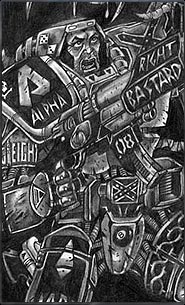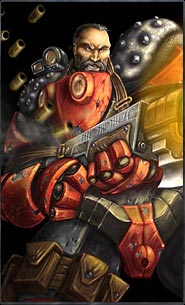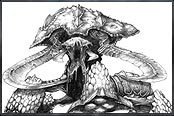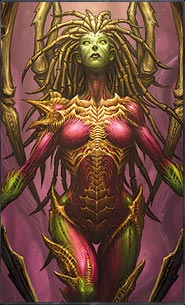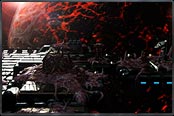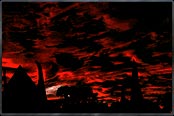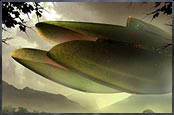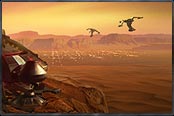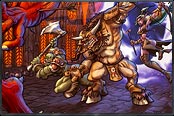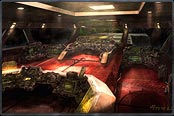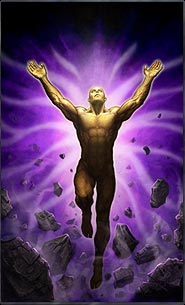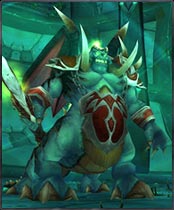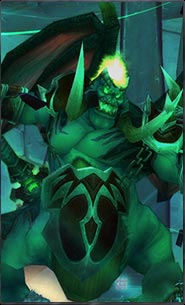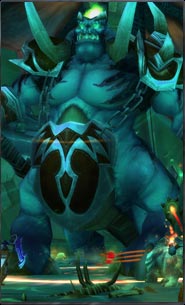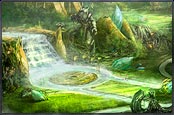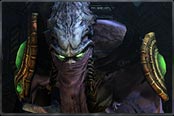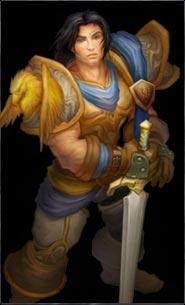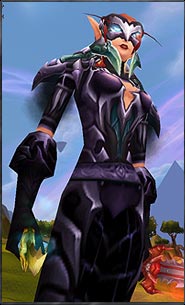BlizzCast Episode 2
When: Episode Two was broadcast on 22nd February 2008
Duration: 49:05
Who: Karune (Kevin Yu), the RTS Community Manager interviews Chris Metzen Vice President of Creative Development. Nethaera of the World of Warcraft Community Team interviews Geoff Goodman a designer on World of Warcraft. Finally, a Q&A with Andy Chambers, Writer for Starcraft and Tom Chilton, Lead Designer on WoW.
Contents
IntroductionEdit
| Blizzcast Index [e] | |
| Episode 1 | Episode 2 |
| Episode 3 | Episode 4 |
| Episode 5 | Episode 6 |
Welcome to our second episode of BlizzCast! We have doubled the length of our second BlizzCast at the popular request of the community, which will begin with an in depth interview of Chris Metzen, our Vice President of Creative Development and creator of our original Warcraft, StarCraft, and Diablo storylines. In addition, Geoff Goodman, one of our World of Warcraft Designers will be elaborating on Magtheridon's Lair changes in Patch 2.4, which includes new itemization changes. Lastly, we are also adding a new community questions and answers section, to make sure your voices are heard and your questions are answered, by none other than the people making your favorite Blizzard games.
[00:17]
Karune: Hello, Internet users. Welcome to our second episode of our BlizzCast series, designed, once again, to take you behind the scenes into the world of Blizzard. My name is Karune, the RTS Community Manager here at Blizzard. First up, we'll be interviewing Chris Metzen, our Vice President of Creative Development about the lore of Warcraft, StarCraft, and Diablo. On top of that, we'll be also bringing in Geoff Goodman, one of our World of Warcraft designers, to elaborate on the newest changes to the Magtheridon dungeon. Lastly, we'll also be answering questions from both the StarCraft and the World of Warcraft communities. Without further ado, we'll get started.
Part One - Interview with Chris Metzen, Vice President of Creative DevelopmentEdit
Welcome, Chris, to the show. In case you guys didn't know, Chris was also the voice in our intro bumper for BlizzCast series.
Chris Metzen: That's right.
[00:58]
Karune: Pretty awesome. To start off, our first question. How challenging is it to develop and manage the lore behind three very distinct franchises: Warcraft, StarCraft, and Diablo? Do you find it jarring when you switch between them or does the variety encourage creativity as you change gears from one to another?Chris Metzen: Interesting. That's two really good questions and I guess I'll just take the first part. How difficult is it to manage the lore behind the three franchises? I think if I was trying to do it by myself, it would be impossible and I'd make just a complete and utter mess of it all.
At the end of the day, Warcraft alone is such a huge setting and such a big universe that there's no way any one person could manage all those characters and places and things. The team we built for World of Warcraft of quest designers and writers is just epic, so these days I get to work with a team of really talented people that really kind of breathe life into the setting.
A lot of my story stuff on Warcraft these days is coming from a very high level, conceptualizing zones and characters, especially looking forward to future expansions – expanded content – I'm really keen to get in there and kind of create the broad strokes of things and then it really goes to special teams. We sit down many times a week and really walk through quest lines and characters and see how it all melds with the art creation process. So that the story-telling of it all is much more of a group activity these days on the Warcraft front.
On StarCraft, it's definitely taken that turn as well. I'm still very involved at the scripting level, at the story-telling level – figuring out how the game moves forward and how it interacts with the cinematics and the whole ultimate linear progression, how that takes shape. But we've got a really amazing team these days, it's absolutely not just a one-man show.On the original StarCraft, it was me and a guy named James Finney who was one of our designers at the time and we pretty much tag-teamed a lot of that story and pretty much defined how the story played out through that single-player campaign. This time around, our lead writer is a guy named Andy Chambers. He's a very good writer; he's worked in science-fiction a long time. We're working with the cinematics director, Nick Carpenter and we're all kind of jamming the story. It's much more of a team effort this time as opposed to the story coming from any singular spot. So, we kind of check-and-balance each other a lot and we're able to kind of draw on our common geeky love for films and science fiction in general. I think it's made the themes really pop this time. It feels like a much more grounded story this time around. I think the characters are a lot richer. I think the highs and lows they experience are just a lot more mature.
We've come a long way since the original StarCraft. We've matured as story-tellers; we've matured as a team. The instincts that define what we dig and what we don't in story-telling are much more honed at this phase of our lives. We were twenty-something back in the day; we're thirty-something now, so all that life experience is definitely playing into the themes we're bringing forward in StarCraft and the way we're handling them. It's really fun. It's been a really rewarding experience. As far as handling continuity, and the broad story for the Diablo franchise, I guess that we'll have to see how that takes shape.
[04:44]
Karune: I think it must have been really crazy, especially working with all the different teams and all the different franchises. How do you think it has been to switch gears between the two or to really…working with each different team, your schedule must be crazy every day.Chris Metzen: At this phase, I've actually cut a lot out of my schedule these days so I only have meetings every hour of the day, so that's good. I'm not double or triple stacked. For many, many years now, I've spent a lot of my time ping-ponging back and forth between different licenses every day. It's always a revolving door. But for me, for my specific personality – we're all wired very differently – I dig that. I dig changing gears all day long. You could be working in the same universe for a day but changing gears on ‘well, this is a level-design meeting,' ‘this is a quest/story meeting,' ‘this is purely VO-let's-get-our-characters-down-what-actors-are-we-hiring kind of meeting,' so, I like that. I like the up and down of the day and never really getting bored with things. It's always moving fast and there's always kind of – as the day goes on, there's always some new challenge that's kind of fresh…
[05:54]
Karune: Do you find those ups and downs kind of influencing each other as far as inspiration?Chris Metzen: Oh yeah. Absolutely. I think it keeps – as far as I go, as I interact with the special teams and the different groups, where my head may have been, in one hour, I walk into a totally different meeting and that energy's still burning off. Or I might just go ‘Gah, you guys just wouldn't believe what we just jammed out in that last meeting!' And they'll go ‘Well tell us!' They might not even care, the animators might not even care what a zone looks like but I'm so geeked up about what we were just doing that I'll wind up babbling to them about whatever we were jamming on. So, it kind of almost creates this educational process where everybody's in the loop and it's just a cool communication thing.
I like the up and down of it but, you can run into trouble sometimes where, if you're walking in from one game to another game, back-to-back creative meetings and come out of a StarCraft meeting with certain themes that were big in our minds and I walk in and ‘Guys, I had this idea for Warcraft blahblahblahblahblah,' and they're like ‘Woah, dude, that sounds just like…there's no laser guns in Warcraft!' ‘Oh, that's right!' So, sometimes you really have to change gears; your clutch can get a little fried, but I dig that kind of stuff and it's just been this way for years. I like being able to work on the different licenses and kind of keep, from an artistic level or a conceptual level, keep the old brain exercised. It's kind of cool to be able to jump around.
Sometimes, when you're focused on a single idea, day in and day out, for a protracted amount of time, it dulls a little bit. At this rate, the way my job is structured, I think it keeps me on my toes, you know what I mean? It keeps me sharp – I hope! My coworkers may not think that's entirely true because I also have a terrible memory – short term memory, I don't even have that. What were we talking about?
[07:58]
Karune: For sure, I think the energy translates quite a bit to the story-line of the games. To talk about StarCraft in particular, how did that particular story-line get started with you?Chris Metzen: You know, it's funny. What a lot of people may not know is we were actually – Nick Carpenter and I, the cinematics director, we were developing, for Blizzard, we were the young Turks many years ago. After we had published Warcraft II. Nick and I spun off and were working on a science-fiction concept for a game that was actually more of an action shooter. It involved pretty gnarly stuff like space vampires, kind of clans of them, and this really cool sci-fi setting.
At the same time, a separate development team, or the main development team at the time was developing science-fiction RTS. We had done Warcraft II and now we're interested in trying to do the next RTS outing in science-fiction. And early ideas like ‘well, let's blend them together man, we can do this kind of space-vampire-clan-thing and real-time-strategy.' We talked about that for a while and ultimately, that game fell through and as momentum really started picking up on the science-fiction thing, the group response is like ‘well, let's simplify this, right. People, they understand space-ships. They understand creepy, spidery aliens. They understand psychic brain aliens, right? So let's just cut down to the core motifs that are really classic in science-fiction. That's where we should start.' So we kind of threw away the world concept we were cooking and ultimately StarCraft just kind of took shape over time. It starts with, the way you build a world, it starts with tanks and fighter jets and just cool-looking alien shapes and ultimately that starts growing into a setting. Who's this? Where's that vehicle from? Who pilots this? I think the StarCraft setting really started taking shape at that conceptual level.
It wasn't the story-line, specifically, the linear flow of events, the overthrow of the Confederacy, Kerrigan, Raynor, the Protoss, the destruction of their homeworld. A lot of that stuff wasn't clear from the get-go. We were just making the broadest science-fiction universe we could and trying to make sure it really resonated with people. It was only in constructing the single-player campaign that James and I really started laying out the broad strokes of how the universe would unfold and what this moment in time was really defined by: the Confederate fall and ultimately the invasion of Aiur. So it's funny, little ideas that weren't there from the beginning: the whole character of Kerrigan didn't really exist until the middle of our construction of that first campaign. We knew we had Ghosts and the joke was – I don't know if this is common knowledge but I think it was Command and Conquer that had a character named Tanya, back in the day. She was kind of like an assassin, a badass. And we just had this conversation one day using a Ghost character on a map, like ‘ha ha, how funny', the whole ice-skater debacle was going on with Tonya Harding and Nancy Kerrigan. ‘Haha, how funny, we'll make our super assassin named Kerrigan on this one map.' And it was a total throw-away character but as we started discussing it and really getting in to this character, we kept coming back to her; she had a lot of gravity. It really created a cool, kind of triangle of tension between Mensk and Raynor and this emergent Kerrigan character. Ultimately, it was pretty late in the game when we decided that she would be betrayed and become the Queen of Blades. The Queen of Blades was never an original concept; it really came about just at that, kind of in the final stretch of that campaign. Just another testament to the fact that what we publish and what people really cling to isn't necessarily always defined from the beginning. You would think, looking at StarCraft, that that was one of the core concepts but actually it was kind of tacked in later. I think that's where we're strong as story-tellers; when you pop ideas like that in the middle of your plan, we tend to be able to jump on those ideas and weave them into the core plot and really make them feel like they've been there from the beginning. That's kind of the trick to it: can we flex fast enough with emergent ideas and really make them feel contiguous?[12:26]
Karune: Yeah, that stories kind of evolve into it rather than set things that you try to throw in. That's really awesome. I think that's different than how some other companies might handle it.Chris Metzen: : I think that's a big part of video game story-telling, you know, you go out and write a movie script or comics are like this a lot. It typically relies on the actor to – pardon me, the writer to have conceived of the thing pretty clearly up front and then you begin to build the mechanical component of the game on top of existing plot-lines or characters. Certainly films are like that. You start with a script. Comics, you typically start with a script.
So, when we construct stories for video games, more often than not, it starts with a molten idea. Sometimes it's broad, sometimes it's not, but as part of this team dynamic, as the special teams get involved and as the designers and the writers and the artists all kind of start talking about this molten idea, it hammers it out further. It becomes clearer and clearer as you go. People respond to characters or themes more than others. Like, you know what, this idea is cool but it just isn't fun. It doesn't play well; it doesn't work in the context of the game. Or, someone might go ‘Hey, what about this character Kerrigan?' and we go ‘Woah, we should absolutely use that! I've got a crazy idea, let's turn it into an alien!' So you never know where those ideas are going to pop so the trick is stay loose and give yourself enough breathing room that you can use those ideas. That you can jump on them without derailing the train.
People typically worry about Blizzard, it takes us a while to get games out. It ain't ready till it's ready. That is obviously a benefit. But one of the things that also happens in our longer gestation period is we're just talking about this stuff all the time and it gives us a little bit of room and breathing space to really chew on some of these ideas that might pop that other companies, with a tighter development schedule, might not be able to chase. They might not be able to really weigh things like that that might pop because it'll derail the train. That's one thing I dig about the freedom we've been allotted all these years is that we're able to really chase those things down and explore.
[14:41]
Karune: So what do you think about the StarCraft II story coming many years now after you developed the StarCraft original story? What has kind of been the popping elements to get that back to the story?Chris Metzen: The StarCraft II story. You know its funny, while I wouldn't say we had a lot of false starts, there were a lot of themes I really wanted it to be defined by when we began. And at this phase, some of those themes have fallen away. Some of them have become even clearer. Ultimately, we had a number of hanging plot threads after the first game. Obviously, you've got the huge thread of ‘Kerrigan's in charge of the zerg now. What's she doing? What's happening with our old buddies Mensk and Raynor? Where are they at? How do they play in to the future of this setting? How can we resolve this split between the Protoss civilization -the Light and Dark Templar? Will that be resolved? And ultimately, the larger mythology question of: why all this? Why now? The Protoss and the Zerg were created by some elder race as suggested – who is that race? And ultimately, was there a plan and a symmetry to all of these events that played out? Was it just random warfare or is there a bigger cycle of events playing out?' So those are a lot of the things we knew about right out of the gate.
We had many years to think about them, mull them around before we started official development on a project. After we've been in this for a while and we've really refined our story-telling process and our cinematic process, this game is much more cinematic than the previous game: we've got a lot of in-game sequences and the story mode space which we showed at BlizzCon last year. So it's been, just a tremendous experience to be able to really get closer to this universe. It's not just talking heads babbling at each other in ready-rooms anymore. You're really immersed in the tension and the drama and the story of it all. These characters are, the artwork, the voice-over and all that stuff, they're just more realized than we've ever really been able to do. It's just been tremendously rewarding to shape this thing and really see it take the shape beyond even what I had hoped for a few years ago.
You kind of have a sense of the story and your expectations and your hopes for it as a singular writer, but as the teams' gotten involved and as we've been jamming on it all these years, the inclusion of fresh voices like Andy Chambers and even old voices like Nick Carpenter, I think we're all doing the best work of our careers. It's funny, I've said a number of times. World of Warcraft kind of became the center of the Blizzard universe, pardon the pun, for many years. The game was so big, it demanded a tremendous amount of mind-share from us all. Even though other games were in development at the time. Certainly StarCraft II.
But now, it just feels like, with StarCraft II, as we're able to focus more and more, it feel s like the best work we've ever done. It's finally the story I really wanted us to tell. It's got a lot of heart, it's got a lot of depth, and, on top of it, it's just a rip-roaring wargame. It's badass. It's been very, very rewarding to see this thing take shape. Just getting back to that Blizzard of yesteryear where it's not all about WoW – don't get me wrong, I love WoW! But we're so much more than that and I think the world will see, when we pop with this thing that we haven't been idle.
[18:30]
Karune: And everybody's quite excited. Let's also use that to shift gears from Warcraft III. How did the story evolve from Warcraft III, an RTS game, jumping into World of Warcraft, the MMO?
Chris Metzen: I think at the end of the day, that you have to remember that we developed both of them concurrently. I was lead writer, creative director on World of Warcraft – sorry, on Warcraft III. Same thing; both. As we were developing Warcraft III, the call came down ‘hey, look, we're gonna try this MMORG thing. We're gonna build World of Warcraft.' Okay. We kind of built them from the conceptual standpoint at the same time, roughly. I knew what the Warcraft III story was, I knew what the new lands were, I knew what cultures were involved and ultimately where all the pieces on the chess board would be by the end of that, considering The Frozen Throne expansion. So as we were developing WoW, we knew where everything was, we knew what the broad themes were, and we were able to build on that snapshot of the world that Warcraft III left you with. So if that was your basis; now we can take those maps and those ideas and those art assets, that fundamental art direction and really launch off into a far broader setting.
At the end of the day, the boxed product of WoW was pretty static in terms of: it kind of re-introduces you to the setting, the world but it didn't have a real strong sense of linear story. That would come, I think, as we got into the Ahn'Qiraj patch event where Ahn'Qiraj comes out and suddenly, no matter where you were, Alliance or Horde, at the level you're at: suddenly, oh! There's an event happening! And the world is kind of bent towards this new episodic content where obviously, with the patches that followed and in Burning Crusade, we began to get back into more of a linear series of stories.
Burning Crusade is a definite chapter, it's a year in the life of this setting. And you could track all the events that played out, right. Wrath of the Lich King again is that next chapter, that next vital offering of events that are pushing this continuity forward where I think WoW is more of a snapshot. I think certainly pushed the continuity forward from Warcraft III but not in as dynamic a way as our current expansion sets are doing. I'm not sure if that answered your question, though.
[20:55]
Karune: Well, I mean, going even further into Wrath of the Lich King, what types of stories – the storyline that was already told in Warcraft III – will be told in Wrath of the Lich King and also what types of loose ends that haven't been told or are going to be introduced in Wrath?
Chris Metzen: Right. A couple that spring to mind – there's all sorts of stuff going on in Wrath of the Lich King – it's big, conceptually, it's like – if you look at Burning Crusade at a conceptual level: we're going into outer space. There's clearly a war between good and evil playing out in the greater universe. There's some sort of predestination of the orcs coming to Azeroth. Now we get to see their origins.
The Burning Legion, the Burning Crusade: it was huge on a conceptual level, right? Some would argue maybe too huge, right. Whatever happened to Gnolls and Kobolds. Suddenly, you're in outer space fighting angels. With Wrath of the Lich King, you almost get both. We come back to terrestrial Azeroth, so it's a little more back into the realm of gnolls and kobolds – well, I'm not promising you'll see either of those in Northrend – it's a little more palatable to classic fantasy. But at the same time, we're also pushing forward hugely on the setting. We're going to get into themes like the Titans and the creation of the world, the function of Azeroth at the dawn of creation. Why this planet? Why does this planet continue to be central to events? The whole dwarven storyline of them trying to plumb the depths of their origins and how that ties into the creation of the world. We're getting into a lot of cool new territory with the war of magic and the creation of the dragon flights – what's their function in the world? How are they currently doing? At this phase of history, there's all sorts of big, broad themes playing out – not the least of which are looking again at the Alliance and the Horde from an overall angle and just gauging “How're they doing, these days?” After the events of that first year of play culminating with – I don't even know what it was – Ahn'Qiraj, Blackwing Lair, Naxxramas, all the big event patches we put out which I kind of look at as Year One, and certainly with the Burning Crusade: both alliances sending expeditions into this burning, alien world and being flung into those events.
What are the stresses that have resulted over time because of those things? What are the discoveries? The discovery of the Mag'har in Outland: what does that do to the Horde? That Thrall's finally found his – where's his head at? The Northrend events, Wrath of the Lich King kind of looks at each of these alliances and how these events have played out and shows you the new stress fractures, perhaps appearing in the upper echelons of leadership. There's new characters kind of coming to the forefront that may or may not challenge the status quo for both factions. There's all sorts of sweet – everybody knows about death knights, but you know, we just had a meeting the other day about how they play out, about how the storylines of potentially Mograine and the Ashbringer and all those events in the Plaguelands: what was the point of all of that and how does it really play out? There's all sorts of little nooks and crannies like that, that Northrend really brings full circle, that the Wrath of the Lich King expansion really brings full circle. So, it's been really fun for me to be able to help steer the setting.
If we were making a comic book series every month, obviously, you've got to roll it out but while our expansion sets, they certainly don't roll out month by month, they are episodic, ultimately, so it's been really cool to push the setting forward and begin to bring some of these characters and points of history back to the forefront so that fans of the story of WoW can really feel immersed and that everything is cohesive and compelling, we hope.
[24:57]
Karune: Very nice. I think that most people are hanging at the edge of their seats right now about all of the Wrath of the Lich King stuff. Our last question: how did the events of the Sin War Trilogy fit into the Diablo universe and why was this an important story to tell?Chris Metzen: At the most basic level, apart from the story of it, in terms of just how the product came to be at a publishing level, we were talking with our partners, PocketBooks, a couple of years ago. “Hey, let's do trilogies per license; for each of these three licenses.” My first instinct was, “hey, killer! Let's use go back and those trilogies to really give people a sense of the origin of each of these series.” Thus, with Warcraft, we did the War of the Ancients which was the definitive, first conflict of Azeroth that really set the stage for everything happening in the current age. StarCraft as well, with the Dark Templar trilogy, even though it was spun with the protagonist kind of reliving history in his mind, it really gave you a sense of the mythology of the Protoss and the events that really echo in the current day, in the pre-staging to StarCraft II.
With the Sin War as well, while we didn't want to get into ‘time-travel' or ‘character reliving history in his head' – it's more of a straight look at ancient events – I think I may be roasted for this, it happened about a thousand years before Diablo I, and really, the Sin War trilogy was meant to take a snapshot of the Diablo world as it was and really show you the events and characters that set in motion everything that plays out in the present day.
Karune: Well, I think that's all the questions that we have for today so thanks a lot, Chris, for joining us.
Chris Metzen: Certainly. Thanks a lot!
Part Two - Interview with Geoff Goodman World of Warcraft DesignerEdit
[26:55]
Nethaera: Welcome everyone to the World of Warcraft portion of BlizzCast Episode II. This is Nethaera of the World of Warcraft Community Team with the ever present Bornakk nearby to help keep the show rolling.
Today, we're going to take a look at Magtheridon's Lair, our 25-player dungeon from the Burning Crusade expansion. Game designer Geoff Goodman is here with us to discuss the evolution of this encounter, along with the newest game changes available in the Sunwell Plateau patch. Welcome to the show, Geoff.
[27:54]
Nethaera: To start off with, could you explain a little bit about your role in the creation of boss encounters like Magtheridon?
Geoff Goodman: Sure. Well, with most encounters, I have got to start off with saying that with every encounter, we have a lot of input from all of the designers. We have a lot of input from the story guys, and Metzen, of course, to get sort of a base, root foundation. From there, we kind of break it down into more specific areas of what we want to focus on. Kind of take the best of the great ideas. And then from there, break it down further to a single person who's actually implementing the encounter and they kind of fill in the details and add abilities where needed, kind of make it all come to life. And that's what I do.
[28:12]
Nethaera: Where does Magtheridon's Lair fit within the progression of boss encounters in Outland? We know that when you first enter into Hellfire Peninsula, that's the first thing that everybody sees when they go into Outland. So, where exactly will this fit?Geoff Goodman: Well, it definitely was intended to be a first tier – one of the first things you hit when you start raiding in the expansion. Much like Onyxia was set up pre-BC. As the past has shown, we've had to make some changes to make him a little easier over time because he ended up being a little harder than intended but that is definitely where he is supposed to fit.
[28:49]
Nethaera: We've seen a little bit of evolution in this encounter and I wanted to discuss that with you a little bit before we delved into the changes that are in the Sunwell Plateau patch. In the Black Temple patch, we saw quite a few changes to the encounter which included easing up on the difficulty of the encounter with adjustments to damage output of Hellfire Warders, Hellfire Channelers, and the Burning Abyssals, as well as some loot table adjustments. Could you explain a little bit more about the design philosophy behind the changes at the time?Geoff Goodman: Sure. We focus a lot on feedback from the forums and from everyone we know that plays it. Before we do any changes, we gather tons and tons of feedback and make sure we're getting all the right information first. Then we look at where people are having the specific problems – in this case, where the encounter's too hard – we look at where we can keep the feel of the encounter intact: we don't want to pull out a whole lot of things if we can help it, try to keep everything together. We look at where we can kind of lessen things, where we can make it easier without gutting the encounter, per se.
In Magtheridon's case specifically, a lot of people, especially a lot of people that have done it, know that the first phase with the channelers is generally considered the harder part which is potentially an issue in any case because you hate to have an encounter where it starts off incredibly challenging and then peters out and you're bored by the end. A lot of the changes in the past and the new ones coming are focusing on the channelers, to try to put them in line with the rest of the encounter.
[30:20]
Nethaera: As part of this evolution, we're making further changes in the patch to entice players back into this encounter and better allow players to experience facing down this infamous pit lord. Rather than just listing out the changes, I'd like to go through the encounter phase by phase to discuss how they are being changed with the patch.Let's start at the beginning with phase one. What are players going into this encounter experiencing now and how is it being changed with the patch?
Geoff Goodman: Well, like I mentioned before, it was definitely considered the hardest part, not only from just a difficulty, numbers standpoint of here's a lot of damage. It was generally the most complicated part of the encounter so…it's kind of nice, sometimes, to have sort of a – in Maulgar's case, a really hard pull or something that makes it challenging right out of the gate. But, as I was saying before, if it ends up petering out and gets kind of boring, you want to take some of that and even out the complication that we use.
We've lowered the difficulty of a lot of things, made them easier to interrupt when they're – when they die, they share powers, they strengthen each other, make themselves cast faster, so that got slowed down a little, make them a little easier to interrupt. The abyssals are generally – were difficult before, they've become a lot easier now. We've pulled some of their abilities that made them a little bit more challenging than intended and generally tried to ease up on the complication more than anything else, as well as dropping the numbers down. First phase, we've definitely hit the hardest.
[31:52]
Nethaera: So, let's move on to phase two. At this point, Magtheridon is let loose and things start to get a little more involved with players. What is happening currently and how is that being changed?
Geoff Goodman: Well, there's a number of things. He has an ability that causes basically instant death if you don't see it coming. We're looking into that, it's still – instant death is always a tricky concept, but as long as it's completely avoidable and it keeps you watching the area and keeps your eyes on the gameplay, it's definitely a positive thing. We just need to make sure that it's something that players see and can see it coming. In this case, the case of debris falling down, I have some changes to make so that it's easier to see, so that it's more – so that the rocks that were falling before the actual debris hit, there should be more of those and they should be a lot more visible, as well as putting an icon on the screen, like a debuff, you should be able to see it coming, so hopefully that will give players more indication. This time, we didn't change anything, just made it easier to see. A lot of stuff like that should help.
[32:45]
Nethaera: That takes us into phase three, of course, where players literally have the ceiling falling down on their heads. Where once, they could relatively safely look down on Magtheridon from above, now nowhere is free of danger. What exactly happens in this phase and what changes can players expect when the sky is, so to speak, actually falling on them? You mentioned that there are better visual cues, now.
Geoff Goodman: That's the big change to that last part of the phase, but as well as when he's channeling and he's – I guess this is a phase two question as well – when you're supposed to use the cubes to break him out, it's about, as I said before, lessening the complication.
In the previous incarnation, you've had this Mind Exhaustion debuff whenever you click a cube that made people switch which, the intention of that is that not all a matter of complication and difficulty but a lot of times, we'll design a cool interaction you get to have with the encounter and we kind of, some of the raids will have like ‘you're the guy who does this cool thing' and everyone else gets to just press their heal button or something. So, we kind of like to spread that around but in this case, it turned out, especially being an introduction raid, that it made the whole thing a little too complicated.
So, in the past, we've lowered the people required to rotate and, in this latest change now, we've decided that you can just have the same people do it. You still get a Mind Exhaustion debuff but the duration will be shorter than you need to click it so you can have the same people cycle the whole time. That will help the complication in general. And, like I said, in phase three, the rocks falling down, getting better indication on that, things like that will help sell it a lot…
Nethaera:People will be able to see what's coming at them.
Geoff Goodman: Yeah, totally.
[34:36]
Nethaera: Lastly, we have some changes to the loot that players can get from him. After all that hard work, we want it to pay off. What can they expect to get out of it?
Geoff Goodman: Well, a kind of funny thing happens when we change these encounters a lot. We'll put these changes out there and a lot of people will try them again, but there's definitely a lot of psychology that sticks around that people avoid things. So, to try to entice people to play the encounter and try out the new changes and everything, we are changing some of the loot.
You'll notice the cash drop, the pure gold drop, will be significantly increased. If you just want money, you know, you have a lock out period, but you still might want to kill him just to get some money, he'll drop a bag, a nice twenty-slot bag. A lot of people really like that Zul'Aman one we put in with the quest, so that's another opportunity to get another twenty-slot bag. He also drops a bag of gems – now this is an important one because it'll drop the epic, uncut gems that are very difficult to get right now. Again, he's on lock-out so it will be kind of hard to farm him but you should feel incentive to want to kill him when you can.
[35:39]
Nethaera: Okay, great. I just wanted to say thank you to everyone for listening in and thanks to Geoff Goodman for taking the time to talk with us.
Geoff Goodman: Thank you very much!
Nethaera: This is Nethaera from the World of Warcraft Community Team handing things off to Bornakk, who will take us into our Q&A portion of the show.
Part Three - Q&A with Andy Chambers, Writer for Starcraft & Tom Chilton, WoW's Lead DesignerEdit
[35:56]
Bornakk: Hi, this is Bornakk from the World of Warcraft Community Team and welcome to our first BlizzCast Q&A session where we'll be answering questions directly from our players and fans.
First up, we have Andy Chambers who is our lead writer and a great source of knowledge for the StarCraft universe. Welcome to the show, Andy.
Andy Chambers: Thank you, Bornakk. It's a pleasure to be here.
[36:15]
Bornakk: The question we have for you today is a bit of a two-parter. What planet is seen at the bottom of the page at starcraft2.com and what is happening at the planet's surface at the red dot? People are referring to it as ‘the explosion.'Andy Chambers: Well, as befits a two-part question, I've got a two-part answer for you. The first one is the lore answer to it all. The planet itself is Bel'shir one of the moons of the Mackan system which has not previously been seen in StarCraft I. It's a Protoss ex-shrine world that was invaded by the Zerg and much of the Protoss have now been pushed out of the area. It keys in with the sort of jungle tile-set that you may have seen in some of our previous videos for StarCraft II. Now, the little explosion as people call it, is actually a vent for an artificial volcano the Zerg have pierced through the surface of Bel'shir to produce a heat-source for their nests full of hot magma –because it saves them having to knit little cozies for their eggs and things like that – so, that's the lore reason.
The actual reason there's a little dot there goes back even further. Goes back to our career announcement. The world that you're actually seeing there is the same sort of brown ringed world that we saw in the announcement behind the space platform. As part of a test during that, some of our artists wanted to do plasma bombardments, little explosions going off all over the world all the time. So, when the guys in the Community Team got hold of this piece of art, they reshaded it into the green world you now see. But as part of that process, one of the little explosions carried over into the new image that you now see.So, as ever, lore must be responsive to art as art must be responsive to lore, so I've incorporated that into the back-story for Bel'shir and it's actually added this little unexpected bonus of like ‘oh, cool, artificial volcano. I like it!'
[38:07]
Bornakk: Awesome. I know a lot of people are looking forward to experiencing the StarCraft universe again. Should be a great time. Thanks for the details there, Andy.
Andy Chambers: My pleasure. Thank you very much.
Bornakk: Next up, we have our World of Warcraft lead designer, Tom Chilton. Welcome to the show, Tom.
Tom Chilton: Hi there. How are you?
[38:39]
Bornakk: Doing good. So, we have a couple of questions for you today. The first is, regarding Retribution Paladins, we've made some recent changes to the class that were very nice and they're wondering if we're going to update the Seal or the Judgement of Command with the new model that we were following.Tom Chilton: Absolutely. What we're trying to do, a big push that we have in the expansion, is to get different specs and different classes to use similar types of gear. What we don't want to have to do is drop different kinds of gear for every single different kind of spec in the game. Unfortunately, that has the side effect of making people feel as though a lot of loot that isn't for them drops. It's great when the item that is for your class, for your spec drops but you've got to figure that there's a whole lot of other classes and specs out there just thinking ‘another item that's not for me?'
So, what we're trying to do is make sure that the items are shared more among the different classes and specs. So, we're really looking towards moving Retribution Paladins farther towards using the same kind of itemization that warriors use and we've made a couple of changes recently in patch 2.3 that kind of go part of the way there. And really, that was just to shore up some of the immediate problems that we were having with it.
Really, we want to go further with that and make sure that across the board, all the different Seals, Judgements, and all the different paladin abilities in general kind of follow that same scheme. But that's something we'll likely be seeing the full effect of in the expansion.
[40:08]
Bornakk: The next question we have is ‘do you have any plans to make more maps for the battlegrounds?' And, what I mean by this is have a new map where you can use the same kind of gameplay as you use in Warsong Gulch.
Tom Chilton: Yeah, we actually do have an idea to be able to do that. I can't say we have absolutely final plans for implementation yet but one of the things we want to move towards – beyond the fact that we're going to be adding a new battleground for the expansion that features siege weapons and destructible buildings – an idea we've had is that we'd like for players to eventually be able to go to the Battlemaster and, for example, they would queue up for a ‘capture the flag' map or they would queue up for a ‘domination' style map or whatever you want to call it. And that would put them in one of a possible variety of different maps that actually feature that gameplay type. The reason being, that way, you can still control the kind of gameplay that you're trying to get into but it allows us to add a whole bunch more maps without spreading players too thin among all the different maps.
One of the problems that we have right now is, that if we continue to add maps, we keep splitting players up between all the different battlegrounds. And, as we split players up more and more between the different battlegrounds, it gets harder to match them up against other, similar opponents, like, for example, pre-mades versus PuGs, or pre-mades with good gear versus pre-mades with very low-end gear. So, it's important to us that, as we add new battlegrounds like this, we really kind of have to re-factor the queue system to make it all work.
[41:36]
Bornakk: Awesome.
The next question is for all those rogues out there. Are there any plans to buff the Subtlety tree in rogues or, specifically, the dagger rogues?Tom Chilton: Well, I don't know that it's a Subtlety-specific problem. We definitely have plans to improve daggers in general. One of the things that was very popular before the expansion came out was the Combat-Daggers build for rogues. That was obviously a very popular kind of raiding spec. And that's kind of fallen by the wayside at this point. Another one that you could point out would be the Mutilate spec, we had issues, at first, with a lot of our mobs being immune to poison. Then obviously, in PvP, it relies more on Seal Fate to build combo points which relies on crit which is offset some by resilience.
So, in general, what we've seen is kind of a trend away from daggers for the rogue and obviously, since daggers are such a big part of the kit for rogues, we want to make sure that the dagger specs are very viable. So, we do expect to, across the board, improve the daggers for rogues in a variety of different ways, but I don't see this as just being a Subtlety problem.
[42:43]
Bornakk: Okay, awesome.
Next question. Do you have plans to add a tab that will have one or two pre-set talent builds that you can switch to when you respec?
Tom Chilton: We definitely want to make the respec process more graceful, especially considering how much respeccing people are doing. Right now, when you respec, it unlearns all the spells that you have that are talent-specific. It takes them off your action bars, et cetera, and, then when you spec into a new spec, it doesn't fill those in for you. Something we'd like to do is have the game remember or be able to save settings with different talent specs so that you can more easily switch between them. That goes along with potentially, in the future, doing some things to ease the burden of respeccing back and forth. If you're doing kind of high-end Arenas, high-end raiding, that kind of thing. Because we do want to encourage players to be able to enjoy a variety of different elements of the game. So, we definitely want to make that whole process more graceful in general.
[43:46]
Bornakk: The next question is: do we plan to have tanking specs get more integrated into PvP? For example, like a new Taunt mechanic?
Tom Chilton: Well, yes and no. To a degree, we definitely want to improve the viability of the tanking specs in PvP. But I only mean that with respects to casual PvP, like battlegrounds. We don't actually have realistic plans to try to make the tanking specs be Arena-competitive, viable specs, necessarily. We feel like it's okay if there are certain specs that really aren't competitive end-game specs. At the same time, we do want to make sure that when you roll into a battleground, that you feel reasonably useful. We don't want you to have to respec every time you go to a battleground or whatever. To some degree, we have that, in that prot warriors, for example, are pretty popular for running the flag in Warsong Gulch. They also can be pretty useful for defending different points of interest, either in Arathi Basin or even in, potentially, Eye of the Storm.
So, we have it to some degree, but we do want to moderate those differences more than we have right now and make them a little bit more viable for PvP than they are but I don't think that the expectation should be that you'll be able to be a high-end, Arena- competitive player.
And certainly, with the Taunt mechanic itself, we don't want to add that as another kind of crowd control over what we have right now. We really feel that if players were able to taunt each other, it would really be just another sort of aggravating, annoying sort of control mechanic that we don't necessarily want to go down that road.
[45"34]
Bornakk: Okay. And the last question is: will PvE players be able to be more competitive in PvP in the expansion? There are a lot of raiders out there who would love to be able to mix up their gameplay but feel they're unable to do so due to the effects of resilience on PvP and so they want to make it more accessible to go between the two.
Tom Chilton: Yeah, definitely. That's something that we have identified as a problem; the crossover for players that are very deep in the end-game PvE not being able to take part in PvP. Although, I wouldn't even necessarily say it's people who are just deep in the end-game PvE, in general, the PvE itemization won't allow you to PvP very effectively. So, that's something that we are not only changing in the expansion, but we also have some pretty significant changes going in in 2.4 to help address that. Specifically, in patch 2.4, we've added a lot of PvP-oriented loot to different areas of PvE without simply just dropping them off a boss of instances.
For example, we have a lot of dungeon-quality PvP loot you'll be able to get through the reputations, the different dungeon reputations, we also have, in the different raid tiers, for example, the Karazhan raid tier, the Tier 4 raiding gear, you'll be able to exchange those set item tokens for the Season One PvP gear. You'll be able to take the Tier 5 and 6 tokens and turn those in for Season Two quality PvP gear. That way, once you've got a zone farmed out, you can actually go back to it for longer to get some PvP gear out of it. It won't necessarily be the absolute best stuff that's in the game, in the same way that if you're just doing PvP, you don't necessarily have the absolute best gear for PvE. But, it should at least get you to a point where you're competitive.
It will also help in the case of where you're rolling up an alt. Let's say you've dinged an alt recently at level 70 and you want to get involved in PvP. You'll be able to both go through instances and do some battlegrounds in order to get geared up and catch up and get into the competitive PvP a little bit more easily.
Bornakk: Alright, that's very exciting! All this should be really a lot of fun when players get the chance to try it all out.
Tom Chilton: We hope so.
[47:58]
Bornakk: Thank you very much, Tom, and Andy, for answering these questions for our fans. Let's also thank Geoff for his insight on the evolution of Magtheridon, and Chris for all his details on the development of the lore for all of our games.
[48:11]
Bornakk: We have one more thing to tell you today. We are happy to announce the 2008 Blizzard Entertainment Worldwide Invitational will be happening on June 28th and 29th in Paris, France. This is a great celebration of our three franchises that brings the company and gamers together. Both the World of Warcraft expansion, Wrath of the Lich King, and StarCraft II will be playable at the Invitational. So, if you can be there and are sixteen years of age or older, we welcome you to join us. Please visit www.blizzard.com for more details on the event.
[48:53]
Bornakk: This is Bornakk on behalf of your Community Team, thank you for listening to this episode of BlizzCast and we'll see you next time!
BlizzCast ResourcesEdit
- Download Episode 2 in .mp3 format - 56mb EU Mirror US Mirror
- RSS Feed
- Official Blizzcast Site
| Blizzard Entertainment & other Game-related Topics [e] Blizz Games Other Games Terms Devs Blizz ppl D3 D2 D1 Other ppl Events Merchandise Related |
|---|
| Blizzard's Games |
|
|---|
| Game Developers |
|---|
| Blizzard People |
Blizzard's Top |
Blizzard All |
Blizzard All cont. |
Ex-Blizzard |
|---|
| Diablo II Team |
|---|
| Diablo I Team |
|---|
| Industry People |
|---|
| Diablo Merchandise |
|
|
|
|
|---|

